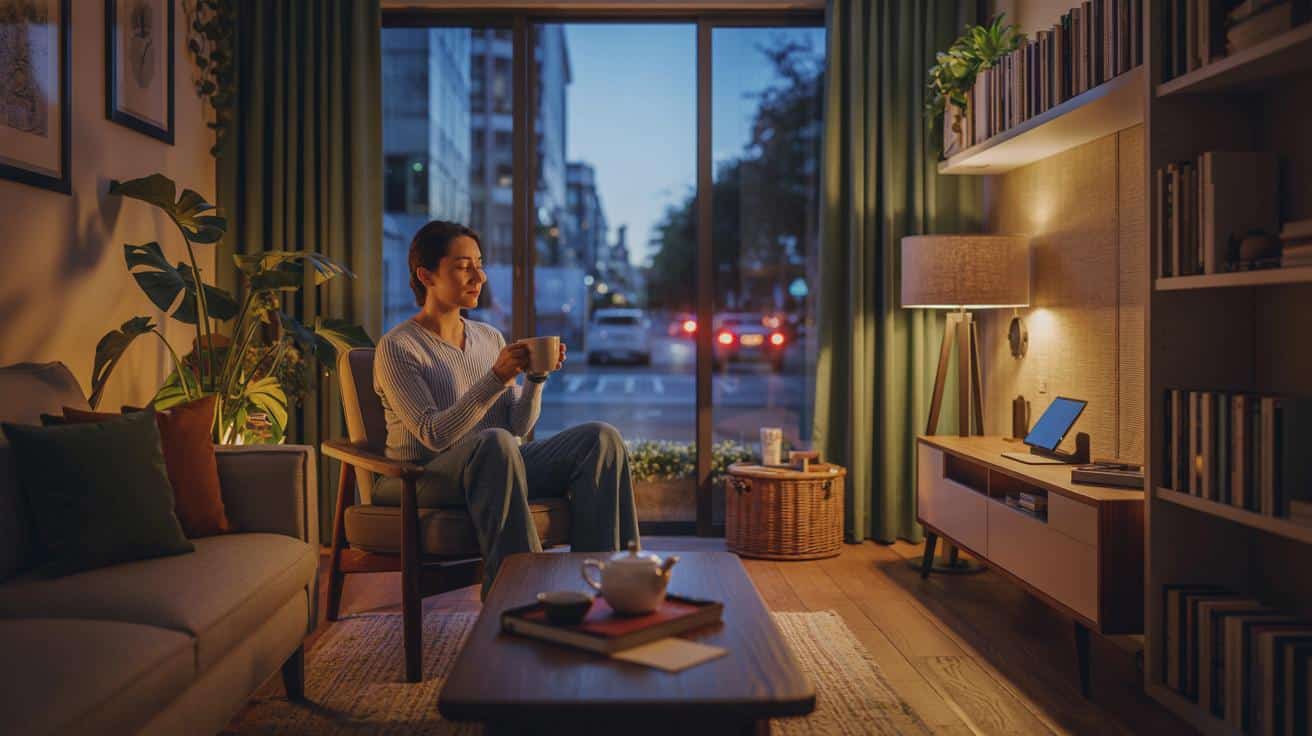The hush your brain has been missing
Traffic growls, alerts ping, and interiors hum with HVAC and screens. Minds strain to parse these layers, burning attention on triage instead of creative thought. Silence still exists, yet few people court it with any discipline or design. Neuroscience now describes how quiet recalibrates emotional tone, stress hormones, and cognitive bandwidth. The benefits reach beyond serenity into sharper memory, steadier mood, and improved sleep. The body does not flourish under relentless acoustical assault; it needs intervals of relief. Families and flatmates also crave a shared texture of calm between obligations. What happens when noise recedes ? People notice breath, posture, and subtle moods that once hid under clatter. **Silence sharpens attention.** Homes can host restorative quiet with small, thoughtful shifts, not monastic extremes. The pursuit begins with ears, yet it ends with the nervous system.
How silence recalibrates mind and body
Brains evolved to treat sound as signal. A snap in the brush once meant danger or dinner. City soundscapes hijack that circuitry, evoking vigilance without resolution, minute after minute. Cortisol creeps upward, heart rate variability falls, and attention fragments across phantom priorities. Silence releases that clenched readiness. The autonomic system downshifts, allowing respiration to lengthen and muscles to unclench. **Quiet rooms slow the breath.**
Neuroscientists track these shifts with measurable markers. Electroencephalography shows increases in alpha activity during intentional quiet, correlating with relaxed alertness. Functional imaging reveals calmer activity in the salience network, which frees working memory for deeper tasks. Sleep researchers observe improvements in slow-wave coherence when evening noise diminishes. These changes do not demand heroic discipline. Even brief pockets of quiet create what some clinicians call micro-restoration, *tiny recesses for an overworked cortex*.
The hippocampus, guardian of memory and spatial mapping, also benefits from auditory ease. Animal studies hint that periods of quiet may support neural plasticity under certain conditions. Human evidence suggests that the brain consolidates information more efficiently when late-day environments mute unnecessary sound. People often report a gentler mood cascade as well. Less noise reduces irritability and rumination, which lowers interpersonal friction at home.
Silence also refines perception. Once the noise floor drops, subtler cues emerge: the rhythm of breath, the timbre of a voice, the creak before a storm. Musicians train this discernment formally, yet anyone can cultivate it. Attentive listening to quiet fosters *sensory granularity*, which psychologists link with better emotion regulation. Clarity grows where cacophony once dominated.
Therapists notice another effect: quiet becomes a mirror. People hear internal narratives that once vanished beneath distractions. This can unsettle, but it frequently catalyzes insight. **Small doses transform stressful days.** The point is not muteness; the point is deliberate relief from unnecessary input. Schedules can honor that relief without ascetic severity.
“Silence is not emptiness; it is the nervous system’s permission slip.”
Parents sometimes worry that silence dulls a lively household. The opposite often happens. Children play more imaginatively when toy sounds do not monopolize attention. Couples also report richer conversation after shared quiet, as if words arrive more considered and kind. What else could a home want than kinder words and steadier energy ?
Bringing quiet home: Design, rituals, and boundaries
Homes rarely arrive acoustically merciful. Yet modest adjustments can lower the sound floor and elevate well-being. Start with the envelope. Thick curtains swallow street noise, especially when they reach floor and wall edges. Bookshelves act as diffusers, scattering echoes and softening sharp reflections. Rugs and upholstered furniture reduce slap-back in hard rooms, adding warmth you can feel and hear. Weatherstripping doors closes gaps that leak outside sounds and drafts.
Windows often carry the loudest burden. Secondary glazing, installed as a removable interior panel, reduces noise without full replacement. Draft stoppers and well-fitted blinds add another layer. Kitchen spaces benefit from felt pads beneath chair legs and cabinet doors, taming clangour at its source. Bedrooms deserve special treatment since night noise fragments sleep and mood. Place the bed away from shared walls, use dense curtains, and keep devices outside.
Technology can support quiet when used judiciously. Rather than constant masking noise, try time-limited pink noise for focused work sprints. Smart speakers can schedule “do not disturb” periods, enforcing digital silence with friendly automation. Phones can live in a charging basket at the entrance, freeing rooms from notification culture. People often underestimate the relief that follows from a single silent hour after dinner.
Rituals anchor these choices. Establish a morning hush before screens, allowing sunlight, tea, and *unhurried thoughts* to set the tone. Consider a weekly one-hour household quiet, with reading, drawing, or mindful chores. Keep conversation, yet keep it low and intentional. Dimming lights magnifies the effect because brightness primes alertness. The body recognizes such patterns and follows them faithfully.
Selection grows easier with clear criteria. Use the following list when choosing acoustic improvements, from curtains to under-door seals:
- Noise source and frequency profile: traffic rumble, voices, appliances, or interior echoes
- Room purpose: sleep, deep work, conversation, or children’s play
- Material density and placement: coverage at edges, corners, and reflective surfaces
- Reversibility and rental constraints: stick-on options versus structural changes
- Budget versus decibel reduction: measurable gains per dollar spent
- Maintenance burden: washable fabrics, modular panels, or durable seals
- Aesthetic fit: colors and textures that invite daily use
- Time horizon: quick wins now, bigger upgrades later
Boundaries protect quiet once you create it. Roommates can agree on headphone hours for calls. Families can cluster noisiest chores, then enjoy a planned lull. Guests can respect a posted “phone on silent” request near the entry. Clear norms free everyone from constant negotiation. Add a small placard or symbol that signals quiet time, and children will often enforce it themselves. Invite buy-in rather than issuing edicts, and the culture shifts gracefully.
When silence helps — and when it hurts
Silence nourishes many minds, though not all at every moment. Some people feel lonely or vigilant in very quiet settings. Trauma histories may complicate reactions, making stillness feel unsafe without support. Pair quiet with grounding anchors such as breath counting, gentle movement, or a short sensory scan. Invite a friend to share a silent tea if solitude feels heavy. Clinicians who integrate quiet often add structure and choice, which increases comfort. Seek varied textures of quiet: soft music without lyrics one day, outdoor stillness the next. People learn their own tolerances and sweet spots over time. Listening to those limits honors the whole person.
| Strategy | What it does | Cost/time | Tips |
|---|---|---|---|
| Heavy curtains and rugs | Absorb reflections, lower room reverberation, warm the soundscape | Medium / weekend | Seal edges; layer rug on rug for tough floors |
| Secondary window panels | Reduce street noise and high-frequency intrusion significantly | Higher / half-day | Choose removable panels if renting; add weatherstripping |
| Ritualized quiet hour | Calms the nervous system, improves attention and mood | Free / daily | Pair with dim lights, warm beverage, and phones in basket |
| Headphone etiquette | Contains call noise, protects shared spaces from spillover | Low / ongoing | Set shared calendar blocks for calls and meetings |
| Pink noise sprints | Masks intermittent distractions during focused work blocks | Low / 25 minutes | Use a timer; return to true quiet between sprints |
FAQ:
- Does absolute silence work better than soft ambient sound ?Many people thrive with true quiet for recovery, then use gentle pink noise for discrete tasks.
- How long should a daily quiet practice last ?Fifteen minutes creates noticeable relief; thirty minutes yields deeper calm and clearer focus.
- Will children accept household quiet without protest ?Kids adapt when you frame it as reading hour, offer choices, and keep it playful.
- Can plants and books really change acoustics ?Yes; books diffuse sound and plants scatter reflections, reducing harsh echoes in hard rooms.
- What if silence triggers uncomfortable thoughts ?Use guided breath, brief journaling, or shared quiet with a friend to anchor safely.








